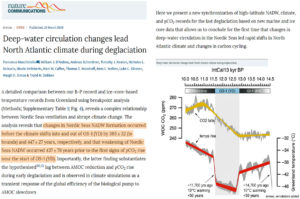by K. Richard, April 4, 2019 in NoTricksZone
A new paper indicates the rise in CO2 concentration occurred well after the Northern Hemisphere’s ocean circulation changes drove the abrupt warming (~11,700 years ago) that ended the last ice age – a lag that effectively leaves no causal role for CO2 during deglaciation.

…
by Roy Spencer, April 3, 2019 in GlobalWarming
Summary: The monthly anomalies in Australia-average surface versus satellite deep-layer lower-tropospheric temperatures correlate at 0.70 (with a 0.57 deg. C standard deviation of their difference), increasing to 0.80 correlation (with a 0.48 deg. C standard deviation of their difference) after accounting for precipitation effects on the relationship. The 40-year trends (1979-2019) are similar for the raw anomalies (+0.21 C/decade for Tsfc, +0.18 deg. C for satellite), but if the satellite and rainfall data are used to estimate Tsfc through a regression relationship, the adjusted satellite data then has a reduced trend of +0.15 C/decade. Thus, those who compare the UAH monthly anomalies to the BOM surface temperature anomalies should expect routine disagreements of 0.5 deg. C or more, due to the inherently different nature of surface versus tropospheric temperature measurements.
…
…
Conclusions
The UAH tropospheric temperatures and BOM surface temperatures in Australia are correlated, with similar variability (0.70 correlation).
Accounting for anomalous rainfall conditions increases the correlation to 0.80. The Tsfc trends have a slightly greater warming trend than the tropospheric temperatures, but the reasons for this are unclear. Users of the UAH data should expect monthly differences between the UAH and BOM data of 0.6 deg. C or so on a rather routine basis (after correcting for their different 30-year baselines used for anomalies: BOM uses 1961-1990 and UAH uses 1981-2010).
by IEA, April 7, 2019
|
Higher energy demand drove up global CO2 emissions in 2018
|
We released our second annual report on global energy trends last week, highlighting that energy demand worldwide grew by 2.3% in 2018, its fastest pace this decade, thanks to a strong global economy and higher demand for heating and cooling. Natural gas emerged as the fuel of choice, posting the biggest gains and accounting for 45% of the rise in energy consumption. Solar and wind generation grew at double-digit pace, with solar alone increasing by 31%. Still, that was not fast enough to meet higher electricity demand around the world that also drove up coal use.
As a result, global energy-related CO2 emissions rose by 1.7% to 33 Gigatonnes (Gt) with coal use in power generation alone surpassing 10 Gt and accounting for a third of total emissions. The majority of that was from coal-fired generation capacity in Asia, with a fleet of young power plants that are decades short of average lifetimes of around 50 years.
|
…
by P. Homewood, April 7, 2019 in NotaLotofPeopleKnowThat
ABSTRACT
It is thought that the Northern Hemisphere experienced only ephemeral glaciations from the Late Eocene to the Early Pliocene epochs (about 38 to 4 million years ago), and that the onset of extensive glaciations did not occur until about 3 million years ago. Several hypotheses have been proposed to explain this increase in Northern Hemisphere glaciation during the Late Pliocene. Here we use a fully coupled atmosphere-ocean general circulation model and an ice-sheet model to assess the impact of the proposed driving mechanisms for glaciation and the influence of orbital variations on the development of the Greenland ice sheet in particular. We find that Greenland glaciation is mainly controlled by a decrease in atmospheric carbon dioxide during the Late Pliocene. By contrast, our model results suggest that climatic shifts associated with the tectonically driven closure of the Panama seaway, with the termination of a permanent El Niño state or with tectonic uplift are not large enough to contribute significantly to the growth of the Greenland ice sheet; moreover, we find that none of these processes acted as a priming mechanism for glacial inception triggered by variations in the Earth’s orbit.
https://www.researchgate.net/publication/23222627_Late_Pliocene_Greenland_glaciation_controlled_by_a_decline_in_atmospheric_CO2_levels

….
La géologie, une science plus que passionnante … et diverse


